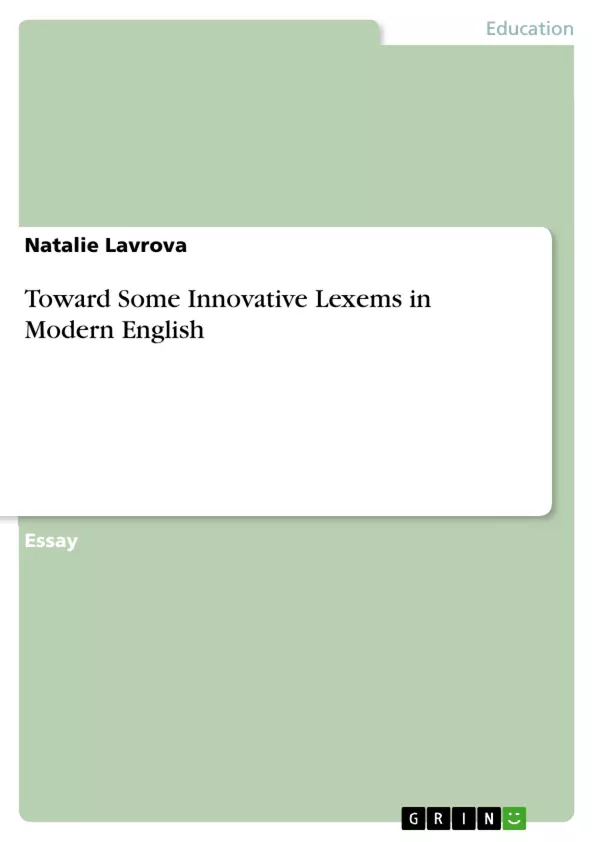The article investigates some occasional formations, which vary considerably on the scale of “conventionality – unconventionality”. Some of the examples cited are on the way to institutionalisation and codification or are simply not regarded by native speakers as facetious or fanciful formations. Other formations are meant to produce a more pronounced response in the recipient – to entertain, to shock, to bring about a smile, a snicker, a chuckle or a laughter. They are not part and parcel of everyday vocabulary and in all probability will never be. They are part of the recreational function of language play, emotionally-charged and/or convey different aspects of a speaker’s evaluation of the referent.
Lavrova N.A.
Toward Some Innovative lexemes in Modern English
There are many irregularities in the language, which can be seen as grammatical or morphological rules only by stretching the idea of either, considerably. According to M.A. Zwicky and Geoffrey K. Pullum (1987), some examples are the irregularities of socio-linguistic competence, poetic form and language games. One of the depreciative constructions in English comprises the Yiddish combination of letters “shm”, which is regularly accompanied by reduplication, for instance: transformations shmansformations, recursion shmercursion, variables shmariables. This is a pithy way of expressing scorn, which gives rise to an infinite sublanguage of English.
It has been claimed that the possibility of a derivational form can be conditional on phonological properties of the base. Thus, D. Siegel (1971, 1974) and M. Aronoff (1976) observe that the insertability of such predominantly obscene expletives as bloody, blooming, frigging, fucking, pissing, sodding, etc. into a word depends on the stress pattern thereof. According to the authors, only base words with a “3…1” stress pattern are eligible for expletive infixation.
The formation of words ending in “-eria”, “-teria”, “-eteria” as fancy names for retail outlets is another case of a morphological phenomenon that has been claimed to hold major implications for morphological theory. D. Siegel (1971, 1974) distinguishes three forms of the suffix in three different phonological environments: 1) “-eria”: basketeria, garmenteria, casketeria, chocolateria, 2) “-teria”: candyteria, noheyteria, radioteria, 3) “-eteria”: caketeria, cleaneteria, luncheteria, smoketeria. The “-eria” variant is found with bases ending in “t”. After vowels or consonants other than “t” the “-teria” version is generally found. It is not really clear where “-eteria” occurs, though it implies that allomorph choice can be determined by phonological considerations. These and indeed many other formations testify to the artistic and playful use of language. Riddling, punning, insult games, deformations, extensions and restrictions found in verbal play are clear deviations from conventional morphology.
Frequently asked questions
What is the main topic of "Toward Some Innovative lexemes in Modern English"?
The text discusses irregularities and innovative formations in modern English vocabulary, including Yiddish-influenced reduplication, expletive infixation based on stress patterns, and the use of suffixes like "-eria" in creating names for retail outlets.
What examples of language irregularities are mentioned in the text?
The text mentions the Yiddish "shm" reduplication (e.g., "transformations shmansformations"), expletive infixation (e.g., using "bloody" or "fucking" within a word), and the creation of retail outlet names ending in "-eria," "-teria," or "-eteria."
How does the text explain expletive infixation?
The text explains that the insertion of expletives like "bloody," "frigging," or "fucking" into a word depends on the stress pattern of the base word. Specifically, base words with a "3…1" stress pattern are considered eligible for this type of infixation.
What is the pattern for forming words ending in "-eria," "-teria," and "-eteria"?
The text outlines that "-eria" is typically used after bases ending in "t," "-teria" is used after vowels or consonants other than "t," and "-eteria" is generally found following other phonological considerations.
What does the text say about "play languages" and their purpose?
The text acknowledges the claim that play languages serve to conceal meaning but argues that advertising and tmesis-based expletives often aim for the target audience to understand the intended meaning. It also argues that a command of play language often implies a command of the natural language involved.
Does the text argue for or against the claim that play languages are primarily for concealment?
The text argues against the idea that play languages are primarily for concealment. It suggests that in many cases, especially in advertising and with expletives, the goal is to make the intended meaning clear to the audience.
What does the author mean by artistic and playful use of language?
The author refers to riddling, punning, insult games, deformations, extensions and restrictions found in verbal play as artistic and playful uses of language that deviate from conventional morphology.
- Citar trabajo
- Natalie Lavrova (Autor), 2010, Toward Some Innovative Lexems in Modern English, Múnich, GRIN Verlag, https://www.grin.com/document/151438



